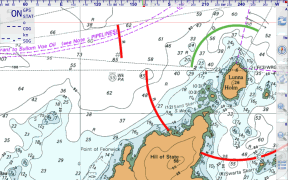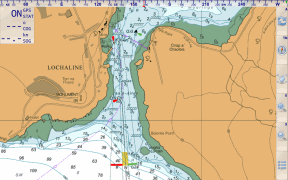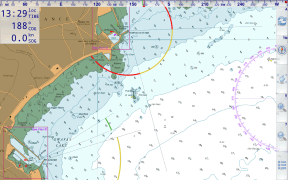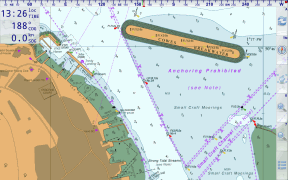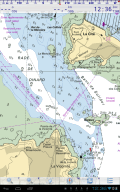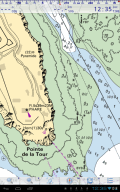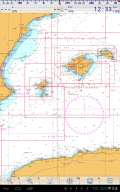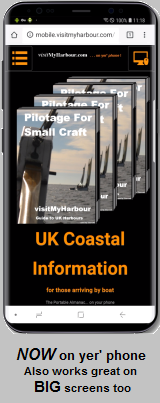About Marine Navigator
Marine Navigator is a "buy and keep" ANDROID app developed by Mr Ronald Koenig and was available in the Google Play Store up till May 2021, where it had many 10, 000+ purchases, and was rated 4.2 out of 5. It is now available directly from us. SEE HERE It is a fully functional chartplotter app, that uses standard free raster charts (KAP files) available for certain areas, like the USA and Brazil. The app can also use encrypted chartsets making available licensed copyright charts for the UK and other areas. Marine Navigator comes with no pre-installed charts, and costs from £9.65. This is the FULL AIS version, unlike the previous PlayStore offering.
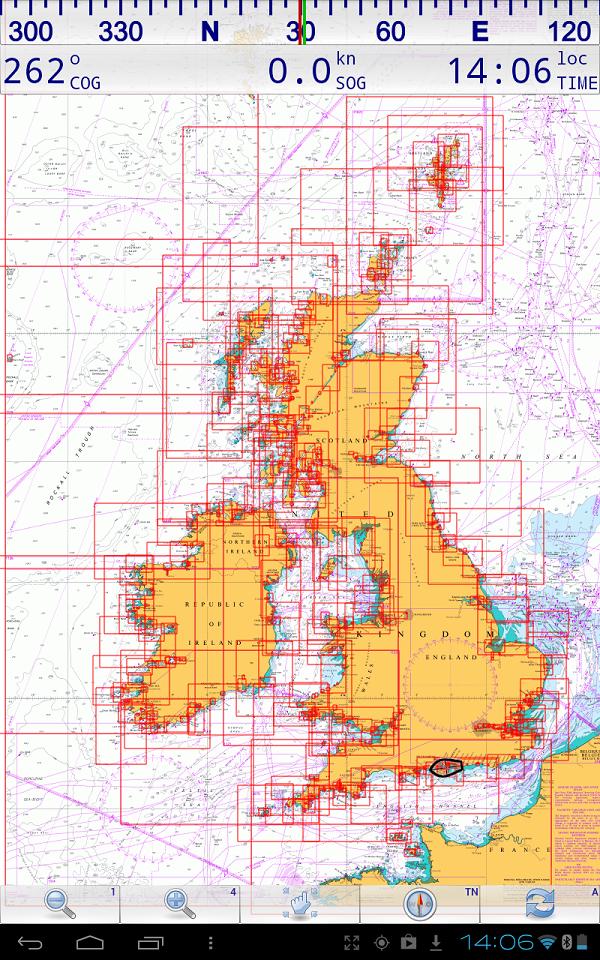
The above screenshot shows the chart outlines in "Marine Navigator"
"The stars of the show were the oldish Aurohelm 200 tiller pilot and Nexus 7 tablet (free with my phone) with a £6.50 app and admiralty charts from Visitmyharbour.com covering the whole of the UK, simply superb, never missed a beat which is more than can be said for the Garmin which has developed back lighting and contrast issues" Cardiff to E.Coast
"Thanks for the great service. The charts on the Android are so superior to the reproductions on the Raymarine - my main navigator with MFD = that I always use the actual raster chart display on the Android for inshore navigation" MC
A new easy chart activation system has been developed for VMH encrypted chartsets with activation codes provided on purchase. Chart purchases / downloads, installation & unlocking are always totally outside of Google Play Store infrastructure for free or paid chartsets.
The Charts:
Made from standard raster charts. You just can't beat the superb detail of raster charts. Vector charts do not have the richness of detail, but are seamless. At VMH we prefer raster every time.
Tap/Click thumbnails to see large image
Tap/Click thumbnails to see large image
Tap/Click thumbnails to see large image
When used with appropriate charts, the app can be used as a stand alone portable chartplotter using the Android tablets' built in GPS (and compass if present). Routes, waypoints and tracks can be used and saved. Charts can be dragged around and switch automatically on zooming in/out.
AIS function is built into the app sold by us. NMEA feed for AIS targets needs to be delivered by wifi network. Small AIS units that provide this are available cheaply, well under £100.
.
Why use an Android tablet ?
Because if you get a decent tablet with 10" screen , and built in GPS and compass using these charts in conjunction with "Marine Navigator" app will give you a fully featured chart plotter, that's "stand alone" and complete. No connecting GPS sets, it's all there already. The charts are fully installed, no internet needed (after installation) , use at sea. Use in the cockpit or chart table. You can get waterproof protective cases for the tablet too. Long battery life, quick start up... what more could you want ?
Why "Marine Navigator" ?
Because we've found it to be so easy to actually use in real seagoing situations. The designer Ronald Koenig, is responsive and continues to update his app all the time. It's versatile.. In addition to our encrypted charts, it can also use standard BSB2/3 charts you may already have. For instance Antares charts for W. Scotland. This app can even calculate routes using Great Circle (for ocean sailors) or Rhumb lines.
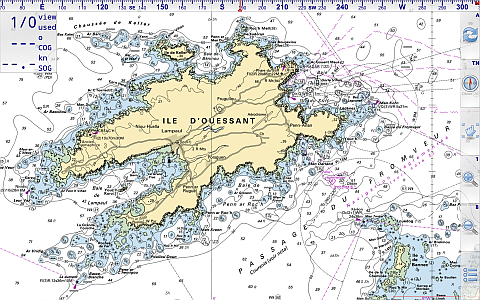
"Marine Navigator is an offline navigator using raster navigational charts (RNC's) to plot your position in real time. This way you can navigate with true copies of official paper charts on your mobile device. This full version of the Marine Navigator provides besides the functionality of the lite version the following enhanced functions:
* automatic chart switching depending on current position and zoom level
* scrolling through all charts available for the current location by "press and hold" zoom buttons
* display of number of available charts for current location in the zoom buttons
* display of outlines of installed charts in active chart
* chart rotation (True North, True Course, Compass Heading, original chart orientation)
* tracks, way points, routes
* follow route automatically
* intuitive route editor
* gpx import and export of waypoints and routes
* gpx export of tracks
* recording of tracks in active and standby mode
* length of recorded tracks only limited by the capacity of the external storage (SDCARD)
* compass (magnetic north, true north)
* different dashboard layouts (basic data, detailed route data, detailed GPS data including graphical status info)
* Man Over Board (MOB) functions"
Our favourite feature so far: Being able to point the tablet at the bows, "Compass Up", and having the "True Course Line" switched on. This show as a dotted line stretching ahead the CMG by the boat. So "at a glance" the navigator can see how much the current is having an effect on the boat at that instant. (Or leeway for that matter).
The "Compass Up" feature also allows you to positively identify buoys or seamarks from a distance, by lining them up with the tablet/phone.
Note: Not ALL Android devices have a built in compass.
AIS screenshots
This example is using an underlying map, not a chart:
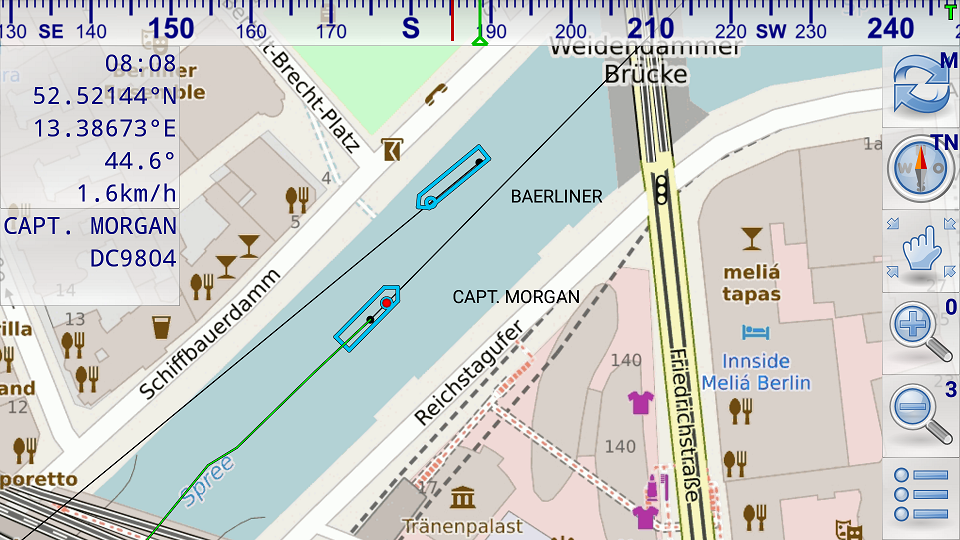
In this picture above both vessels have send position reports and static voyage related data (name of vessel, call sign, ...). The black dots show the last received position. The black lines show the predicted course. The position of the vessel is calculated based on the data of the last received position report (position, COG, SOG). The dimensions of the vessels are taken from the last received static voyage related data report. Capt. Morgan is selected therefore its detailed data are shown in the upper left corner of the screen and its track based on the previously received position reports is shown by a green trailing line. Capt. Morgan has not specified its destination. Therefore destination information is missing below the call sign.
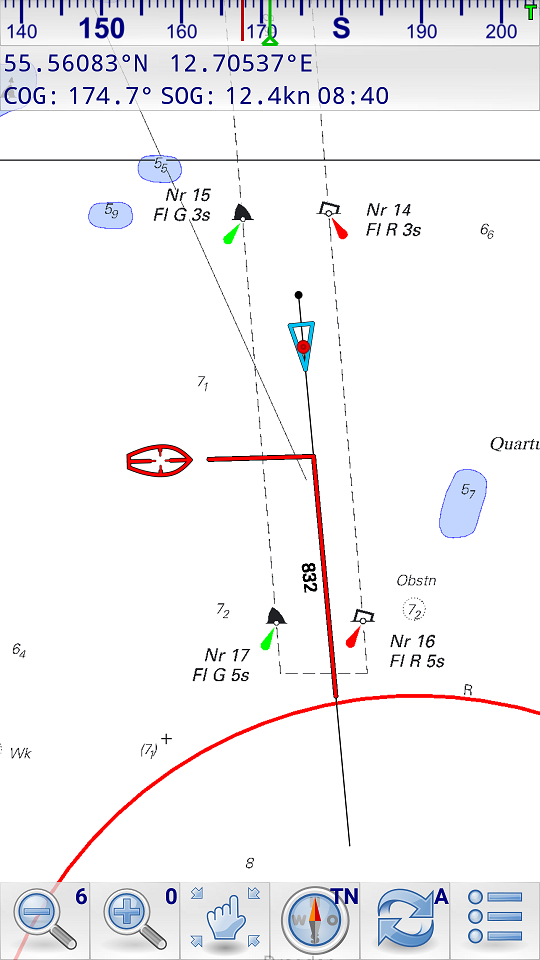
This picture above shows a collision alert. The red line on the own course line shows the passing distance when the other vessel crosses the own course line. The red line on the course line of the AIS target shows the passing distance when the own vessel crosses the course line of the AIS target. In the illustrated case the own vessel will cross 832m behind the AIS target. The AIS target (red cursor) is selected. It hasn't send any static voyage related data yet. Therefore only data of the position report is shown (position, SOG, COG).


